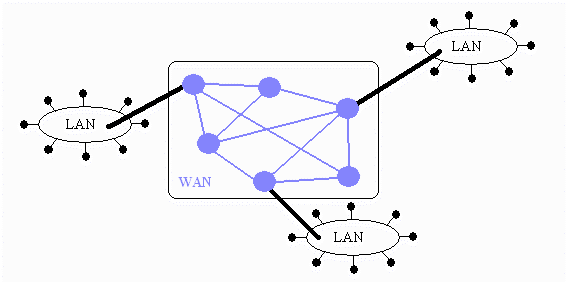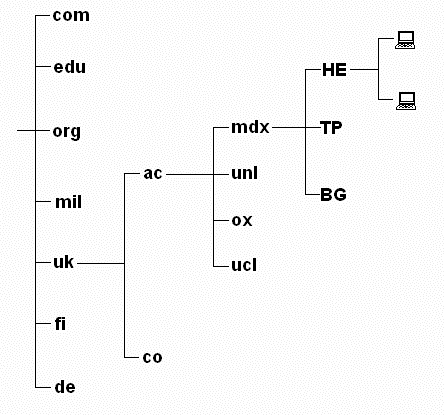
June 2010 Edition
Computer Science Department, University of Cape Town
 | MSc-IT Study Material June 2010 Edition Computer Science Department, University of Cape Town |
The following are the key points you should have provided in your answers.
Packet switching:
Advantages:
no transmission delay
flexible
load balancing
Disadvantages:
re-assembly problems results in jitter
increase in network traffic can cause an increase in delays
Circuit switching:
Advantages:
direct line enables fast transmission and jitter avoidance
data transmitted at a constant rate
Disadvantages
expensive
rigid
poor load balancing
redundancy
delay, while connection is found between two devices
The following are the key points you should have provided in your answers.
LANs
Located in a small geographical area, usually an office.
Formed usually by a server and many (5-55) end devices.
Communications between end-systems is usually via broadcasting i.e. every device attached to the network receives a signal transmitted by one device (some protocols vary, but are essentially still broadcasting).
Usually owned by the same company.
WANs
Cover a large geographical area.
Composed of many switching nodes.
Usually not owned by one company
Communication is via packet or circuit switching
The components are:
user-device, e.g. terminal.
many user devices connected via a LAN
many LANs connected in different geographical locations forming a WAN

The following are the key points you should have provided in your answers.
Livelock
Livelock is a misinterpretation that achieves nothing.
Lifetime is attached to each transmitted packet.
When the lifetime expires, the packet is removed and a re-request issued.
Disadvantages of a router re-assembling packets:
Packet switching allows each packet to be independent.
Independence means that each packet can follow a different path, and hence travel via different routers.
If routers were responsible for re-assembly, the packets would lose their independence.
Each packet associated with a document would have to follow the same path.
If routers are busy reassembling packets, their performance at routing data will be impaired.
Re-assembly:
A packet can easily be lost.
When the lifetime of a packet has expired, do not continue the re-assembly process
When lifetime is expired send a re-request signal and restart.
The maximum number of Internet end-systems is the same as the maximum number of IP addresses, that is 2554, i.e. 4,228,250,625, roughly four billion.
The following are the key points you should have provided in your answers.
Hierarchy is need, otherwise each router would have to store 4 billion addresses
This means that each router only has to store the devices within its domain
Dotted notation and how humans relate to it (instead of using numbers)

The list should include:
source and destination addresses
data lifetime
the source data itself (surprisingly many people forget this!).
packet identification - necessary for re-assembly
protocol - the protocol used to send the packet
data length - the amount of data sent in one packet
Your answer should include the following key points:
SMTP can only send data in 7-bit ASCII character set
MIME is able to send different file formats including JPEG, GIF, MPEGs etc..
MIME has no limit on the size of the message being sent
MIME allows attachments
The following summary explanation of a postal service may sound strange couched in networking terms, but it is expressed this way to highlight the parallels between such a service and internetworking.
To communicate between networks, the data is packaged into envelopes by the sender and an address is marked on the envelope for the designated receiver.
The envelopes are sent to the receiver.
If the address on the envelope is external to that local area, then the envelope has to be passed onto the next nearest sorting office where it is briefly stored, and then passed onto the next sorting office.
This continues until the address of the town on the envelope matches the address of the town that the sorting office resides in.
The transport of envelopes between sorting offices can take different routes. For example, Lorry (i.e. truck) Z leaves Sorting Office A and later informs Sorting Office A, by mobile telephone, that there is heavy traffic on the motorway (the preferred chosen pathway). Consequently the next lorry leaving Sorting Office A, Lorry Y, takes an alternative route and arrives at the destination before Lorry Z.
When the envelopes arrive at the sorting office, they are sorted into sacks where an arbitrary route is taken by the postman to deliver the envelope to the respective address.
If a package does not arrive at a destination, a complaint is made by the receiver to the respective sorting office, where they make a backwards trace to find the package, and if need be, get the user to send the package again (free of charge).
If a package is corrupted (e.g. a person in the sorting office spills their cup of tea all over the envelope, destroying the contents, but the address is still intact on the front), the receiver will not be able to read the contents of the message sent and therefore re-requests the sender to re-send that package